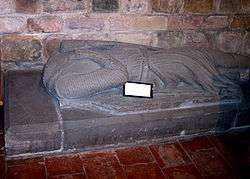William de Ferrers, 5th Earl of Derby
.svg.png)
William III de Ferrers, 5th Earl of Derby (about 1193 – 28 March 1254), was an English nobleman and major landowner, unable through illness to take much part in national affairs. From his two marriages, he left numerous children who married into noble and royal families of England, France, Scotland and Wales.
Life
The son of William de Ferrers, 4th Earl of Derby, and his wife Lady Agnes de Kevelioc, daughter of Hugh de Kevelioc, 3rd Earl of Chester, and his wife Lady Bertrada de Montfort, he accompanied King Henry III to France in 1230 and attended Parliament in London in the same year.
Like his father, he suffered from gout from youth and after the 1230s took little part in public affairs, travelling always in a litter. He was accidentally thrown from his litter into the water while crossing a bridge at St Neots in Huntingdonshire and, although he escaped immediate death, never recovered from the effects of the accident.
Succeeding to the title of his father in 1247, he only lived another seven years and, dying on 28 March 1254, was buried in Merevale Abbey, Warwickshire.

He was succeeded by his son Robert de Ferrers, 6th Earl of Derby, who in 1249 had been married to the King's niece and knighted. Being too young to inherit at his father's death, wardship of the heir's estates was granted to the King's eldest son, Edward I.
Landholdings
Unable to play any part at court or at war, he followed his father in managing the family's landholdings. Their original lands were centred on Tutbury Castle, stretching beyond Staffordshire into the south of Derbyshire and the west of Nottinghamshire. The death in 1232 of his uncle Ranulf de Blondeville, 6th Earl of Chester, brought vast new areas: the estate of Chartley Castle, much of Lancashire between the rivers Ribble and Mersey and many manors in Northamptonshire and Lincolnshire. He continued the policy of encouraging the growth of towns and markets, exploiting the forests of Needwood and Duffield Frith, and taking advantage of rising prices in commodities and land values. By the time of his death his income placed him among the top six of English nobles, but he also left his son considerable debts.[1]
Family
With Sybil Marshal
He first married Lady Sibyl Marshal, daughter of William Marshal, 1st Earl of Pembroke, and his wife Isabel de Clare, 4th Countess of Pembroke, having seven daughters:
- Agnes (died 11 May 1290), married as his second wife William de Vesci.
- Isabel (died before 26 November 1260), married (1) Gilbert Basset, of Wycombe, and (2) as his second wife Reginald II de Mohun, of Dunster, father-in-law of her sister Joan.
- Maud (died 12 March 1298), married (1) Simon de Kyme (died 1248), (2) William de Vivonne (died 1259), and (3) Amaury IX, Viscount of Rochechouart.
- Sibyl, married as his first wife Frank de Bohun, of Midhurst, great-nephew of Savaric FitzGeldewin.[2]
- Joan (died 1267) married (1) Sir John de Mohun, of Dunster (died 1253) and (2) as his first wife Sir Robert Aguillon, of Addington.
- Agatha (died May 1306), married Hugh Mortimer, younger son of Ralph de Mortimer.
- Eleanor (died 16 October 1274) married (1) William de Vaux, (2) in about 1252 Roger de Quincy, 2nd Earl of Winchester, and (3) in about 1265 Roger de Leybourne.
With Margaret de Quincy
In 1238, he married Lady Margaret de Quincy (about 1218 - 12 March 1280), daughter of Roger de Quincy, 2nd Earl of Winchester, and his wife Lady Helen of Galloway. (When her father married her husband's daughter Eleanor, she became both stepmother and stepdaughter of Eleanor.) With Margaret he had two sons and three daughters:
- Robert, his successor. He married (1) Mary, daughter of Hugh XI of Lusignan, Count of Angoulême, and a niece of King Henry III, (2) in 1269 Eleanor, daughter of Sir Humphrey V de Bohun, of Kimbolton, and Eleanor de Braose.[1]
- William who, granted by his mother the manor of Groby in Leicestershire, assumed the arms of de Quincy. He married (1) Anne, possibly widow of Colbán, Earl of Fife and daughter of Alan Durward, their son being William de Ferrers, 1st Baron Ferrers of Groby, and (2) Eleanor, daughter of Matthew de Lovaine, who after her husband's death was abducted by and married to William Douglas.
- Joan (died 19 March 1309) married Thomas de Berkeley, 1st Baron Berkeley.
- Agnes married Sir Robert de Musgrove, of Kemerton, Boddington & Deerhurst.
- Elizabeth married (1) William Marshal, killed at the Battle of Evesham in 1265 (2) Dafydd ap Gruffydd, a prince of Gwynedd.
References
- 1 2 Maddicott, J. R. (2004), "Ferrers, Robert de, sixth earl of Derby (c.1239–1279)", Oxford Dictionary of National Biography, Oxford University Press, retrieved 30 May 2017
- ↑ The Sibyl de Ferrers who married John de Vipont, Lord of Appleby, was her aunt.
- Cawley, Charles, Medieval Lands Project on William de Ferrers, 5th Earl Derby, Medieval Lands database, Foundation for Medieval Genealogy ,
- Complete Peerage
- Sanders, I.J. English Baronies: A Study of Their Origin and Descent, 1086-1327, 1960
- Weis, Frederick. The Magna Carta Sureties, 1215, 1997
| Peerage of England | ||
|---|---|---|
| Preceded by William II de Ferrers |
Earl of Derby 1247–1254 |
Succeeded by Robert III de Ferrers |